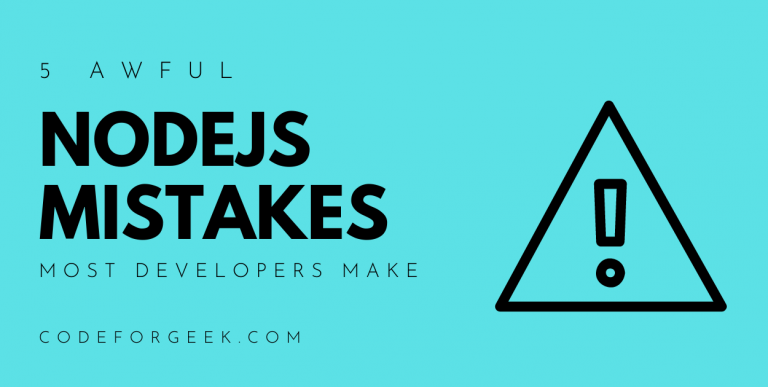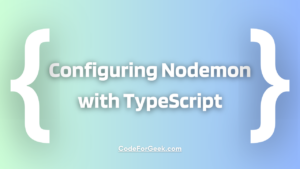Today I am talking about the most awful Nodejs mistakes most developers make.
Since the time Nodejs was revealed to the world, it has seen a fair share of admirations and criticisms. In fact, it still is. The debate never ends and may never at least anytime in the near future.
What we often fail to notice in these debates is that every programming language and platform is literally denounced based on certain issues, which are more often resulted by how we use them.
Regardless of how Nodejs makes it difficult to write code safely, and how easy it makes to write code that is highly concurrent, it must not be forgotten that the JavaScript runtime has been around for more than a decade now. Moreover, it has gained popularity by building tons of robust, sophisticated, and stable web services that scale well throughout their endurance of time on the web.
However, just like any other programming language, developers especially beginners are vulnerable to commit Nodejs mistakes resulting in problems and issues. Some of these mistakes falter performance, meanwhile, others make it as if Nodejs is straight out unusable for whatever on earth you are trying to achieve!
In this article, I will take you through the top 5 awful Nodejs mistakes that developers new to Nodejs often commit and the best possible solutions to them, so you can keep in mind and avoid them, the next time you sit for development.
Also read: 5 Incredible Nodejs Frameworks for Web Apps that Work Like a Charm
5 Nodejs Mistakes Most Developers Make
Considering and avoiding these common yet awful Nodejs mistakes are useful whether you are a company planning to hire Nodejs developers or simply learning the technology to build beautiful Nodejs applications.
Let’s dive right in without wasting any more of your time!
#1 Blocking the Event Loop
Nodejs is built on a single-threaded environment. This means no two parts of Nodejs code can run together at a given time.
Hence, if you are trying to block the event loop, you are actually ending up blocking everything.
Solution
The only way to not make this Nodejs mistake is by using an open-source module known as StrongOps or any other similar modules.
StrongOps enables you to identify and fix any delays that are occurring in the event loop and help prevent you from blocking the event loop.
#2 Executing Multiple Callbacks all at Once
This is the most common Nodejs mistake made by developers, mostly beginners, and sometimes even senior-level developers make.
In case you didn’t know, callbacks are an essential way to enable asynchronous elements to allow communication with each other.
There are times when developers executing the same callbacks or multiple callbacks several times, all at once, which is very awful. Doing this can simply lead to an interface freeze.
Therefore, it’s recommended you regularly ensure you are not continuously executing callbacks multiple times or repeating code mistakenly.
Solution
The first way out is that you can wrap the callback. This will keep you notified each time a callback is executed more than once.
The second solution is to add a return keyword before the callback which will stop the execution of the code once it is complete. This also helps to prevent invoking the same callback more than once.
#3 Trapping in Callback Hells (Deeply Nested Callbacks)
A deeply nested callback is popularly known as callback hell. It primarily consists of multiple nested callbacks that are complicated, difficult to read and comprehend & impossible to debug the written code.
A few Node JS developers see callback hells as inevitable, however, the fact is otherwise.
Read More: Callbacks in Nodejs: A Comprehensive Guide for 2021
Solution:
There are several ways you can escape out of callback hell and keep your code easy-to-read and debug with the help of promises.
A promise primarily refers to a value that is returned to confirm the processing done by an asynchronous function. In short, promises can be nested to make complex code look clearer and easier to read, write, maintain and debug.
You may also make use of the async module, besides promises. The async module provides straightforward, powerful functions to work with asynchronous JavaScript code.
#4 Failing to Test Thoroughly
You just cannot call a Node JS application complete, if you haven’t written the required test codes for it.
Testing in Nodejs is critical yet most often ignored during the Node JS development process.
Solution:
When developing a Node JS application, it is always recommended that you always perform a code inspection and repetitive testing. Doing so can enable faster and smoother development of your applications.
As Emma Hill said:
“The first draft is black and white. Editing gives the story color.”
Emma Hill
I say,
“The first draft is always flaws and blunders. Testing gives the story color.”
Aneesha S
And your story is your app 😉. So, make sure you test it be it 100 times or more!
There are already many tools out there to help you test your application, like Jasmine, Mocha, etc. These write tests and inspect your code for any Nodejs mistakes you must have made.
#5 Using Console.log for Debugging
The Console.log in Nodejs has been misused by using it to debug. For those of you who may know not, it was created so that developers could print almost anything to the console. Hence, when developers use it to debug their application, it restarts the server. This at last slows down the performance of the application.
If you’re someone who uses the console to debug your application’s code, each time something goes wrong, your application code ends up becoming unusable. Which is absolutely unamusing.
Solution:
Here’s the good news. There is a solution to this problem that is quite simple: simply use the Debug Library.
The Debug Library is designed specially to help prevent the console logs from getting printed out while in debug mode. With this, all your files and documents remain secure.
Conclusion
Since the time Nodejs was revealed to the world, it has seen a fair share of admirations and criticisms. In fact, it still is. The debate never ends and may never at least anytime in the near future.
In this article, I will take you through the top 5 awful Nodejs mistakes that developers new to Nodejs often commit and the best possible solutions to them, so you can keep in mind and avoid them, the next time you sit for development.
Noteworthy References
Dangerous Nodejs Mistakes – Medium
Common Nodejs Mistakes – Toptal





